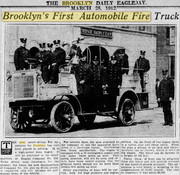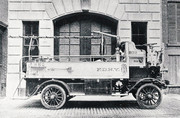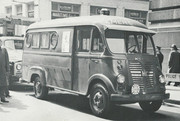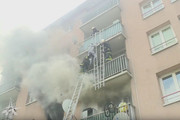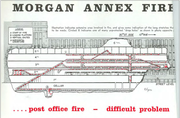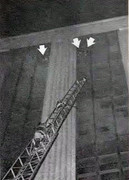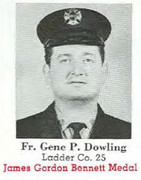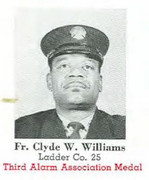68jk09 said:
^^^^^In regard to the text in mack's reply # 343 above ....^^^^^ In the in the second to last paragraph note the reference to ...."Hooked and small extension ladders were brought to the upper floors in elevators after removing the escape hatches from the car ceilings"..... Well this used to be a practice done with a Scaling Ladder in the projects (if need be) until "elevator surfing" became a practice so in the '70s the escape hatches were sealed eliminating that Life Saving possibility of bringing a scaling Ladder butt first out the hatch to an upper project floor .....in R*2 we had the Shops make a 2 section Scaling Ladder (connected with a sleeve & a hardened steel pin) this was carried into the '80s when the Scaling Ladders were removed from FDNY service....(several theories on why the removal occurred ) .
FIREHOUSE
"End Of An Era"
Paul Hashagen explains how modern technology necessitated the invention and eventual demise of scaling ladders.
June 1, 1997
On July 11, 1996, a message was sent to all the New York City firehouses that would bring to a close a chapter in firefighting history. FDNY Department Order Number 73 stated:
"2.3 Scaling Ladders
The Department has evaluated the necessity for maintaining Scaling Ladders as a part of our inventory of firefighting tools and equipment. Based on that evaluation we have determined that scaling ladders will no longer be used by this Department."
Fireman John Binns of FDNY Ladder Company 3 uses a scaling ladder to make a rescue after a fire broke out at the St. George Flats apartment house on the night of April 7, 1884.

The origins of scaling ladders in the FDNY can be traced to a snowy night and a building that burned on Park Row, near City Hall. Flames swept through the World Building on Jan. 31, 1882, and despite many spectacular rescues, the lives of 12 people were lost. Many of those who died could not be reached by the wooden extension ladders carried on fire apparatus. (The FDNY would not purchase aerial ladders until 1886. The apparatus was distrusted since one of the city's most beloved chiefs, William Nash, was killed during an aerial demonstration in 1875.)
As a direct result of this blaze, the department began to reassess its tactics and equipment. Fire Commissioner Henry Purroy made the following resolution, which was adopted:
Whereas: there have recently been constructed in this city a great number of large flats and business houses, reaching in many cases to a height exceeding one hundred feet; and whereas the extreme height to which it is possible to stretch and manage extension ladders have been probably reached, and does not exceed seventy feet, thus making futile the best efforts of this Department toward rescuing the occupants of the upper stories of the buildings above mentioned whenever such occupants are cut off from escape from below; therefore be it. Resolved, That the Chief of Department be and is hereby instructed (keeping in view the increased height of the buildings mentioned) to report to this Board in writing his views in regard to what improvement in the appliances and complements of the Department what changes in regard to the erection and construction of fire-escapes, and what regulation as to the construction and maintenance of fire-proof shutters are necessary, together with any suggestions in regard to the better protection of life and property he may deem advisable.
Chief of Department Eli Bates worked diligently on the problem and brought in Foreman Chris Hoell of the St. Louis Fire Department, who had recently patented a new type of ladder known as the Hoell Life Saving Appliance. The ladder was approximately eight feet long and had one center beam with rungs that extended outward from the middle and an L-shaped hook at the top.
Hoell demonstrated his ladder and the New Yorkers were impressed. Bates went immediately to the fire commissioner and among the things the chief requested was that each hook and ladder truck be equipped with scaling ladders and that the firemen in those companies should be trained in their use.
The ladders were purchased and placed first on key companies, and then eventually on all ladder trucks. Hoell stayed on to teach their use in the department's School of Instruction as the ladders made their way out into the field. The new equipment was in place. The firemen were trained, and eager to put their new skills too work. It would be just a matter of time before their expertise would be called upon.
First Scaling Ladder Rescue
The St. George Flats, an apartment house located at 223 and 225 East 17th St., was advertised by its owners as being "absolutely fire proof." The handsome structure, actually made up of two buildings, was seven stories in the front and eight in the rear. The building's front was blue stone, with Nova Scotia stone trimmings and terra cotta ornamental panels. Polished marble columns flanked the front entrance. A passenger elevator ran up the center of the building, and two dumbwaiters served each side of the structure in the rear. It was an appropriate home for many prominent and well-to-do families.
At about 11 P.M. on April 7, 1884, the elevator boy, Louis Castigan, took a gentleman to view a vacant third-floor suite. When they returned to the elevator, the boy noticed smoke in the elevator shaft, and whisked the man down to the first floor. As the gentleman stepped out, Castigan remarked, "The house must be on fire." The boy then descended with the elevator to the cellar to warn the building engineer and to locate the source of the smoke.
Castigan found the engineer, Frederick Kimmelberg, attempting to extinguish a growing fire in the cellar. He sent the boy to notify the fire department. Castigan ran to the street fire alarm box at 2nd Avenue and 17th Street and pulled the handle transmitting the alarm.
Returning to his elevator, he noticed many people were fleeing the smoke from the floors above. Conditions were deteriorating rapidly in the elevator shaft but the boy set off in his elevator for the seventh floor to warn Mrs. Lockwood and the other two people he thought were still in their top-floor apartment. Castigan made his way through both suites but could find no one. He tried to return to his elevator but was driven back by the intense heat and smoke pumping up through the shaft.
Unable to descend the stairs, he was driven toward the front of the building. Castigan took refuge in the Lockwoods' library, closing the door behind him. He opened the window and poked his head out. The windows on either side of him were spewing clouds of dark, ugly smoke, and the room behind him was also quickly filling with the noxious fumes. The lad yelled for help and was assured by voices in the crowd below that firemen were on the way.
The first-due unit, Engine 5, was already on the scene. With no ladders, they were unable to reach those at the windows above, and concentrated on attempting to control the fire that had taken hold of the stairs. Chief Bresnan arrived at the same time as Ladder Company 3, and with a quick size-up, ordered the pompier ladders out. Firemen John Binns, Thomas Barrett and M.C. Graham, all of whom had been trained in the use of the scaling ladders, grabbed one each and dashed to the building.
Binns reached the fire building first and began his climb. Fastening his ladder to the second-floor window sill, he ascended to a seated position on the sill, then drew the ladder up behind him, and repeated the procedure again and again, scaling the front of the building. As Binns stood on the sixth floor sill, one floor below the stranded boy, other members of Ladder 3 lowered the large extension ladder to the sill next to Binns. Barrett and Graham were following the first man up the front of the structure as Binns stepped onto the top of the ladder and raised the scaling ladder to the seventh-floor window.
With conditions behind him becoming severe, Castigan was forced out onto the window sill. Straddling the sill, the boy guided the hook end of the ladder into the frame. Binns climbed up to the youth, and placed his arm across the lad's shoulders. He assured him he would be all right and briefly explained his plan to take him down the ladder. The fireman then slowly descended the ladder with the boy and transferred him onto the extension ladder. As they stepped to the ground, the crowd of spectators began to cheer. This was the first practical test of the new ladders, and it was a success.
As a result of this rescue, Binns was promoted to assistant foreman (lieutenant) and awarded the James Gordon Bennett Medal, the FDNY's highest award.
Another Spectacular Rescue
On Oct. 25, 1916, a fire broke out on the third floor of 21 East Houston St. in lower Manhattan. The seven-story loft building was filled with workers on the upper floors. On the fifth and sixth floors, 15 girls were busy at sewing machines. On the top floor seven men were working in a steam laundry.
In the street a man was waiting for his fiancee to end her workday when he saw smoke coming from the third-floor window of the building. While he dashed for the local fire alarm box, the tenants of the building were becoming aware of the fire. The owners of the pants company led their employees down the stairs to the street, then realized that only seven of the 15 had made it out. They advised arriving fire companies of those still trapped inside as the red trucks screeched to a halt before the smoke-filled building.
In the rear of the building a woman, Miss Ida Goldberg, became visible through the thick smoke at a top-floor window. People on the roof of the shorter building next door called up to her, pleading with her to wait for the firemen. Miss Goldberg peeked out of the billowing clouds of thick, hot smoke and looked down at the shaft that was formed by the L shape of her building and the structure next door. She faced a sea of flames behind her and a drop of seven stories below her.
"I can hang on a minute or two more but that's all!" she coolly shouted back to them.
Firemen burst onto the roof of the adjoining roof and began to make some daring rescues. Using a small painter's ladder, firemen balanced themselves over the shaft and were able to remove two men, one who was clinging to a metal window shutter a few floors below Miss Goldberg. This ladder was too short to be of any usefulness in her rescue, so a scaling ladder was pulled up to the exposure roof by rope and brought to the shaft.
Above, Miss Goldberg took some small consolation seeing the men below her rescued but just 15 feet across the shaft from her, flames were blowing out the factory windows. The smoke and heat waves building behind her told her that the fire was approaching.
On the roof below, Fireman John Walsh of Ladder Company 8 approached the shaft and needed no orders. He knew the woman above him needed help, and she needed it now. Walsh stepped up onto the parapet wall with the scaling ladder in his hands. Fireman John Devine moved in behind him and grasped the back of Walsh's belt as the fireman leaned out across the shaft and drove the tip of the scaling ladder through the fifth-floor window. He pulled the ladder down to set it in the window frame.
With help from another fireman, the bottom of the scaling ladder was held steady as Walsh climbed onto the bottom rungs. Walsh looked over his shoulder and told the men to let go. The ladder and Walsh skidded across the face of the building, swinging like a pendulum through the clouds of smoke pumping from nearby windows.
As the ladder's motion slowed, Walsh began to climb. Devine then reached out and climbed onto the top of the fourth-floor window shutter and swung from shutter to shutter, across to a position that let him climb to the sill next to Walsh. Together they raised the ladder to the sixth-floor window and Walsh again climbed followed by Devine.
Fire conditions were now becoming so severe that Ida Goldberg was forced nearly out the window. She clung precariously to the smoldering ledge above them. Walsh called to her and explained what he was going to do. She helped seat the ladder as Walsh and Devine lowered it in, and leaned far out to avoid the terrible waves of heat as Walsh began his ascent.
A longer scaling ladder was being placed into position below the firemen who were now almost lost in the smoke. Miss Goldberg's clothes began to burn and flames began to burst over her head as Walsh approached the top of the ladder. She could wait no longer as another wave of heat forced her from the window. Sensing her plight, Walsh stopped and snapped his life belt hook onto the central rail of the ladder just as she tumbled from the window and into his arms. The fireman fought to hold her as Devine struggled to contain the ladder.
The window above them filled with fire as the men shielded the burned woman and brought her safely to the roof of the adjoining building. Eight months later, Walsh was presented the Bennett Medal and Devine received the Wertheim Medal for their scaling ladder exploits.
The Morgan Post Office on 9th Avenue was the scene of a five-alarm fire on the night of Dec. 15, 1967. The 10-story building covered an entire city block and nearly 60 companies would be needed to control the fire that raced through the chutes used to move mail bags from floor to floor. Above the command post three postal workers appeared at a sixth-floor window (with the high ceiling design of the building it was the equivalent of 10 stories).
Ladder Company 25 positioned itself on the sidewalk and even with it's 100 foot aerial fully extended it was realized it would not reach. Fireman Gene Dowling climbed up onto the aerial followed by Fireman Clyde Williams and together they made their way to the tip off the ladder. The first attempt to seat the scaling ladder was frustrated by the ornamental masonry surrounding the window. Operating on the tip of the ladder was further complicated by 30- mph winds that pulled at the men as they tried to hold the scaling ladder over their heads. Their second attempt at placing the scaling ladder's hook into a climbing position was successful.
Dowling crossed from the aerial ladder to the single-beamed ladder and ascended into the wind-whipped darkness above. At the top, Dowling helped one of the trapped workers onto the ladder and started down. Waiting at the tip of the aerial was Williams, who took charge of the first victim while Dowling started to climb again. For a second time, he returned to the top of the scaling ladder; this time, however, he faced the additional problem of dealing with a nearly hysterical victim. Dowling calmed the person as he retraced his route to the tip of the aerial.
Fireman Don Pizzuto had joined Williams and helped to hold both the scaling ladder and the victims steady in the frigid wind. Dowling returned with the third victim down and each of the firemen started down with a cold, frightened but now safe postal employee in his charge.
Seven months later, the trio of brave firemen joined the ranks of the Bravest on the steps of City Hall, where all were decorated for their bravery. Like Binns and Walsh before him, Dowling now wore the James Gordon Bennett Medal on his uniform.
From John Binns to Gene Dowling, the firefighters of New York City extended the reach of their aerial and ground ladders by using scaling ladders, skill and bravery to save those who surely otherwise would not be saved. Their trained and sure techniques were handed down from generation to generation. Modern technology made the scaling ladder a necessity in 1882 and it would be safety and modern technology that would be its demise. Thermopane windows and life belt hooks that could no longer be simply snapped around a gooseneck would make the pompeirs too difficult to operate. The Bureau of Training was also looking to reevaluate the number of classes devoted to scaling ladders in the Probationary Firefighters School (six classes). After weighing all the pros and cons, it was decided to remove scaling ladders from service.
For 114 years, firefighters in New York City brought dozens of people to safety over scaling ladders made of both wood and aluminum. The ladders are gone but not the memory of the brave souls who climbed them.
- Paul Hashagen, a Firehouse? contributing editor, is an FDNY firefighter assigned to Rescue Company 1 in Manhattan. He is also assistant chief of the Freeport, NY, Fire Department.
https://www.firehouse.com/home/news/10544909/end-of-an-era

